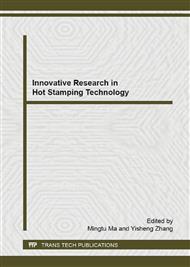p.314
p.318
p.322
p.330
p.334
p.339
p.345
p.350
p.354
Experimental Platforms and Finite Element Analysis on Hot Stamping Processes
Abstract:
Due to the complexity of hot stamping mechanism, including the coupling of material formability, thermal interaction and metallurgical microstructure, it makes the process design more difficult even with the aid of the finite element analysis. In the present study, the experimental platforms were developed to measure and derive the friction and heat transfer coefficients, respectively. The experiments at various elevated temperatures and contact pressures were conducted and the friction coefficients and heat transfer coefficients were obtained. A finite element model was also established with the experimental data and the material properties of the boron steel calculated from the JMatPro software. The finite element simulations for the hot stamping forming of an automotive door beam, including transportation analysis, hot forming analysis and die quenching analysis were then performed to examine the forming properties of the door beam. The validation of the finite element results by the production part confirms the efficiency and accuracy of the developed experimental platforms and the finite element analysis for the process design of hot stamping.
Info:
Periodical:
Pages:
334-338
Citation:
Online since:
December 2014
Authors:
Price:
Сopyright:
© 2015 Trans Tech Publications Ltd. All Rights Reserved
Share:
Citation:


